हनुमानगढ़ का इतिहास
दिल्ली से लगभग 400 कि.मी. दूरी पर स्थित हनुमानगढ़, सड़क और रेल द्वारा अच्छी तरह से जुड़ा हुआ है। हनुमानगढ़ अपने मंदिरों के लिए लोकप्रिय है। यह कभी सिंधु घाटी सभ्यता का एक हिस्सा था, इसलिये इसका एक ऐतिहासिक महत्व भी है। क्षेत्र में हालिया उत्खनन से उस युग के मानव इतिहास से संबंधित कुछ आश्चर्यजनक, महत्वपू्र्ण कलाकृतियों का पता चला है।
हनुमानगढ़ एक कृषि बाजार स्थल भी है जहाँ कपास और ऊन को हाथकरघे पर बुना जाता है और बेचा जाता है। यह क्षेत्र अपने रंगारंग त्यौहारों की वजह से प्रसिद्ध हैं, इनमें से खास हैं; भद्रकाली मेला, गोगामेड़ी मेला, पल्लू मेला, शिला माता मेला, महताब सिंह यादगारी मेला आदि। इनमें से कुछ त्यौहार साप्ताहिक और कुछ वार्षिक रूप से मनाए जाते हैं। उत्तर भारत के तीर्थयात्री इन त्योहारों में बड़ी संख्या में शामिल होते हैं। हनुमानगढ़ को मूल रूप से ‘भटनेर’ कहा जाता था क्योंकि यह भाटी राजाओं का राज्य था। जब बीकानेर के राजा सूरज सिंह ने मंगलवार (भगवान हनुमान को समर्पित एक दिन) के दिन शहर पर कब्जा कर लिया तो उन्होंने इसका नाम बदलकर ‘हनुमानगढ़’ रख दिया। दिल्ली-मुल्तान राजमार्ग पर पड़ने वाला यह क्षेत्र उन व्यापारियों के लिए एक महत्वपूर्ण यात्रा मार्ग का भाग था, जो मध्य एशिया, सिंध और काबुल से दिल्ली और आगरा भटनेर होते हुये जाते थे।
हनुमानगढ़ कैसे पहुंचे:
हवाई मार्ग:
हनुमानगढ़ के लिए निकटतम हवाई अड्डा चंडीगढ़ हैं जो (312 किलोमीटर) है और वहाँ से मुंबई, दिल्ली और देश के अन्य प्रमुख महानगरों से दैनिक उड़ाने हैं।
चंडीगढ़ मुंबई, दिल्ली और देश के अन्य प्रमुख महानगरों से दैनिक उड़ाने हैं। हनुमानगढ़ के लिए निकटतम हवाई अड्डा (312 किलोमीटर) है।
सड़क मार्ग :
हनुमानगढ़ सड़क मार्ग से जयपुर, दिल्ली, लुधियाना, चंडीगढ़ और जोधपुर से अच्छी तरह से जुड़ा हुआ है। कार किराए पर लेना सबसे अच्छा विकल्प है, लेकिन कई बस सेवाएं उपलब्ध हैं, निजी और राजस्थान राज्य सड़क परिवहन निगम द्वारा संचालित भी हैं।
रेल मार्ग: हनुमानगढ़ में जालोर, आगरा, दिल्ली, जयपुर और गुवाहाटी के लिए हनुमानगढ़ रेलवे स्टेशन पर सप्ताह भर में कई ट्रेनें है।
पर्यटक आकर्षण :
हनुमानगढ़ जिले में और इसके आसपास कई पर्यटक आकर्षण स्थल हैं।
ऐतिहासिक आकर्षण :
भटनेर का किला: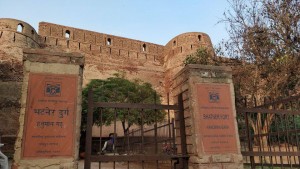
हनुमानगढ़ का प्राथमिक पर्यटक आकर्षण भारत का सबसे पुराना किला, ’भटनेर का किला’ है, जो एक खूबसूरत संरचना है, जिसका इतिहास हजारों साल पुराना है। घग्गर नदी के किनारे स्थित यह किला 253 ईस्वी में जैसलमेर के राजा भाटी के पुत्र भूपत द्वारा बनाया गया था। युद्ध हारने के बाद, राजा भूपत ने घग्गर नदी के आसपास के जंगलों में शरण ली। वहाँ उन्होंने अपने लिए एक सुरक्षित महल का निर्माण किया, जिसे भटनेर किले के नाम से जाना जाने लगा। पूरे किले को ईंटों से बनाया गया है, जो 52 एकड़ के क्षेत्र में फैला हुआ है और इसे एक समानांतर चतुर्भुज आकार में बनाया गया है, जिसमें प्रत्येक तरफ एक दर्जन कोट या बुर्ज बने हुये हैं। किले में भारी किलेबंदी की गई है और इसमें कई शानदार द्वार हैं। इसमें अनेको मंदिर हैं जो भगवान शिव और भगवान हनुमान को समर्पित हैं। 1100-800 ईसा पूर्व के चित्रित ग्रे सामान और पहली-तीसरी शताब्दी के रंग-महल सामान, दीवार के साथ स्थित कुअें की खुदाई में पाया गया।
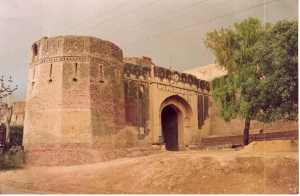 तेरहवीं शताब्दी के मध्य में, बलबन (दिल्ली के सुल्तान) के चचेरे भाई या भतीजे शेर शाह सूरी देश के इन हिस्सों में सूबेदार थे। 1398 में तैमूर ने भट्टी राजा राव दूलचंद को हरा कर भटनेर को जीता था। इसका उल्लेख “तुजुक-ए-तैमुरी” (तैमूर की आत्मकथा) में किया गया है कि यह किला भारत के सबसे मजबूत और सुरक्षित किलों में से एक था। अपने भारत पर आक्रमण के दौरान, तैमूर ने 92,000 की अपनी मुख्य सेना जो उसके पोते के तहत दिल्ली की ओर बढ़ रही थी, उस में से 10,000 सैनिकों को लिया और भटनेर किले पर कब्जा कर के शहर को तहस-नहस कर उसकी किलेबंदी को नष्ट कर दिया। मुगल सम्राट अकबर की पुस्तक “आईना-ए-अकबरी” में भी इसकी किलेबंदी का वर्णन पाया जाता हैं।
तेरहवीं शताब्दी के मध्य में, बलबन (दिल्ली के सुल्तान) के चचेरे भाई या भतीजे शेर शाह सूरी देश के इन हिस्सों में सूबेदार थे। 1398 में तैमूर ने भट्टी राजा राव दूलचंद को हरा कर भटनेर को जीता था। इसका उल्लेख “तुजुक-ए-तैमुरी” (तैमूर की आत्मकथा) में किया गया है कि यह किला भारत के सबसे मजबूत और सुरक्षित किलों में से एक था। अपने भारत पर आक्रमण के दौरान, तैमूर ने 92,000 की अपनी मुख्य सेना जो उसके पोते के तहत दिल्ली की ओर बढ़ रही थी, उस में से 10,000 सैनिकों को लिया और भटनेर किले पर कब्जा कर के शहर को तहस-नहस कर उसकी किलेबंदी को नष्ट कर दिया। मुगल सम्राट अकबर की पुस्तक “आईना-ए-अकबरी” में भी इसकी किलेबंदी का वर्णन पाया जाता हैं।
चौदहवी शताब्दी में यह किला भाटियों, जोहियों और चायलों के हाथों में था। 1527 में इसे 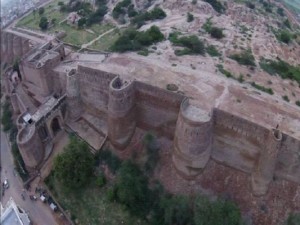 बीकानेर के राव जेतसिंह द्वारा जीत लिया गया। इसके बाद यह चायल और बीकानेर के शाही परिवारों के कब्जे के अलावा, मुगल नियंत्रण में भी दो बार आया। शोधकर्ताओं का मानना है कि मोहम्मद गोरी और पृथ्वीराज चौहान के बीच लड़ी गई तराइन की प्रसिद्ध लड़ाई का क्षेत्र जिले का वर्तमान तलवाड़ा झील का क्षेत्र है। यह किला मध्य एशिया से भारत के आक्रमण के रास्ते में एक मजबूत अवरोधक के रूप में काम करता था। 1805 में, इस पर बीकानेर के सम्राट सूरज सिंह ने कब्जा कर लिया और राजस्थान के गठन तक उनके शासन में ही रहा।
बीकानेर के राव जेतसिंह द्वारा जीत लिया गया। इसके बाद यह चायल और बीकानेर के शाही परिवारों के कब्जे के अलावा, मुगल नियंत्रण में भी दो बार आया। शोधकर्ताओं का मानना है कि मोहम्मद गोरी और पृथ्वीराज चौहान के बीच लड़ी गई तराइन की प्रसिद्ध लड़ाई का क्षेत्र जिले का वर्तमान तलवाड़ा झील का क्षेत्र है। यह किला मध्य एशिया से भारत के आक्रमण के रास्ते में एक मजबूत अवरोधक के रूप में काम करता था। 1805 में, इस पर बीकानेर के सम्राट सूरज सिंह ने कब्जा कर लिया और राजस्थान के गठन तक उनके शासन में ही रहा।
कालीबंगन
कालीबंगन में सिंधु घाटी सभ्यता के अवशेष पाए गए थे। ये अवशेष 2500 ईसा पूर्व के हड़प्पा और पूर्व-हड़प्पा बस्तियों के हैं। कालीबंगन में उत्खनन से हड़प्पा मुहरों, मानव कंकालों, अज्ञात लिपियों, टिकटों, तांबे की चूड़ियों, मोतियों, सिक्कों, खिलौनों, टेराकोटा और गोले का पता चला है।
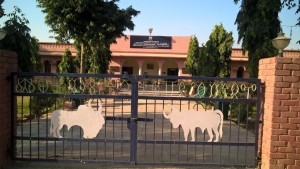 पुरातत्व संग्रहालय: इस संग्रहालय की स्थापना 1983 में की गई थी। 1961-1969 के दौरान हड़प्पा स्थल पर की गई खुदाई से प्राप्त सामानों को संग्रहीत करने के लिए संग्रहालय की स्थापना की गई थी। इस संग्रहालय में तीन दीर्घाएँ हैं – एक पूर्व-हड़प्पा और दो हड़प्पा की कलाकृतियों के लिए समर्पित हैं।
पुरातत्व संग्रहालय: इस संग्रहालय की स्थापना 1983 में की गई थी। 1961-1969 के दौरान हड़प्पा स्थल पर की गई खुदाई से प्राप्त सामानों को संग्रहीत करने के लिए संग्रहालय की स्थापना की गई थी। इस संग्रहालय में तीन दीर्घाएँ हैं – एक पूर्व-हड़प्पा और दो हड़प्पा की कलाकृतियों के लिए समर्पित हैं।
अधिक जानकारी के लिए कृपया मुख्य मेनू ‘पुरातत्व’ के तहत में ‘हनुमानगढ़ की विरासत’ को पढ़ें।
धार्मिक आकर्षण:
श्री गोगाजी का मंदिर
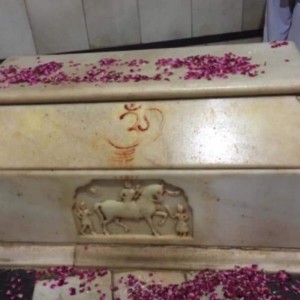 हनुमानगढ़ शहर से लगभग 120 किलोमीटर दूर गोगामेड़ी नामक एक गाँव में श्री गोगाजी का मंदिर है। किंवदंती है कि गोगाजी एक योद्धा थे, जिनके पास आध्यात्मिक शक्तियां थीं। उन्हें ‘सांपों के देवता’ के रूप में भी जाना जाता है। मंदिर एक ऊंचे पर्वत पर स्थित है और यह लगभग 900 साल पहले बीकानेर के महाराजा श्री गंगा सिंह द्वारा उनके सम्मान में बनाया गया था।
हनुमानगढ़ शहर से लगभग 120 किलोमीटर दूर गोगामेड़ी नामक एक गाँव में श्री गोगाजी का मंदिर है। किंवदंती है कि गोगाजी एक योद्धा थे, जिनके पास आध्यात्मिक शक्तियां थीं। उन्हें ‘सांपों के देवता’ के रूप में भी जाना जाता है। मंदिर एक ऊंचे पर्वत पर स्थित है और यह लगभग 900 साल पहले बीकानेर के महाराजा श्री गंगा सिंह द्वारा उनके सम्मान में बनाया गया था।
मंदिर की वास्तुकला में मुस्लिम और हिंदू शैलियों का सम्मिश्रण है । मंदिर के ऊपर दो मीनार हैं, जिसमें मुख्य मूर्ति है। यह मंदिर पत्थर और चूने के मोर्टार से निर्मित हैं इसकी फर्श सफेद और काले संगमरमर की टाइलों से बनी हुई हैं। सभी धर्मों के लोग इस मंदिर में आते हैं। मंदिर में घोड़े की पीठ पर गोगाजी की एक सुंदर, उत्कीर्ण प्रतिमा है, जिसमें उनके हाथ में एक भाला और गले में एक सांप है।
वह एक स्थानीय देवता है और अत्यधिक पूजनीय है। यह माना जाता हैं कि वे सर्पदंश और अन्य बीमारियों से पीड़ित व्यक्ति को ठीक करने में सक्षम है। गोगाजी की न केवल राजस्थान में बल्कि मध्य प्रदेश, उत्तर प्रदेश, पंजाब, हरियाणा और हिमाचल प्रदेश में भी पूजा होती है।
गोगाजी की पौराणिक कथा
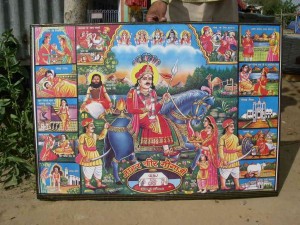 महाराजा गोगाजी राजस्थान में एक लोकप्रिय चौहान वंशीय राजा थे। उनका मूल नाम जाहरवीर था। उनके मौसेरे भाई अरजन-सरजन दुष्ट इरादे वाले थे और अपनी पत्नी रानी सरियल का अपहरण करने के बाद जाहरवीर की हत्या करना चाहते थे। जाहरवीर ने उनकी योजना जान ली और उन्हें मार डाला। जराहवीर की माँ बाछल यह सहन नहीं कर सकी और उन्होने राजा को राज्य छोड़ने का निर्देश दिया। तत्पश्चात जाहरवीर ने महल छोड़ दिया और एक जंगल में रहने लगे। हालाँकि वह अपनी पत्नी से गुप्त रूप से मिलते रहे। आखिरकार उनकी मां को इन मुलाकातों के बारे में पता चल गया। जाहरवीर अपनी माँ को फिर कभी महल में न आने की आज्ञा की अवहेलना करने के लिए अपने को दोषी मानते हुये उन्होंने गोगामेड़ी में अपने घोड़े के साथ मैदान में खुद को जमीन में गाड़ लिया।
महाराजा गोगाजी राजस्थान में एक लोकप्रिय चौहान वंशीय राजा थे। उनका मूल नाम जाहरवीर था। उनके मौसेरे भाई अरजन-सरजन दुष्ट इरादे वाले थे और अपनी पत्नी रानी सरियल का अपहरण करने के बाद जाहरवीर की हत्या करना चाहते थे। जाहरवीर ने उनकी योजना जान ली और उन्हें मार डाला। जराहवीर की माँ बाछल यह सहन नहीं कर सकी और उन्होने राजा को राज्य छोड़ने का निर्देश दिया। तत्पश्चात जाहरवीर ने महल छोड़ दिया और एक जंगल में रहने लगे। हालाँकि वह अपनी पत्नी से गुप्त रूप से मिलते रहे। आखिरकार उनकी मां को इन मुलाकातों के बारे में पता चल गया। जाहरवीर अपनी माँ को फिर कभी महल में न आने की आज्ञा की अवहेलना करने के लिए अपने को दोषी मानते हुये उन्होंने गोगामेड़ी में अपने घोड़े के साथ मैदान में खुद को जमीन में गाड़ लिया।
गोगामेड़ी उत्सव
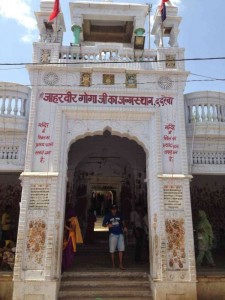 गोगाजी की याद में अगस्त में गोगामेड़ी में एक भव्य मेला लगता है। भाद्र माह के कृष्ण पक्ष की नवमी (गोगा नवमी) से ग्यारहवें दिन तक मेला लगता है। यह त्यौहार पर्यटकों के आकर्षण का एक बड़ा केंद्र है।
गोगाजी की याद में अगस्त में गोगामेड़ी में एक भव्य मेला लगता है। भाद्र माह के कृष्ण पक्ष की नवमी (गोगा नवमी) से ग्यारहवें दिन तक मेला लगता है। यह त्यौहार पर्यटकों के आकर्षण का एक बड़ा केंद्र है।
मेले में पूरे राजस्थान के भक्त उत्साह के साथ भाग लेते हैं और उन्हें शहद, चीनी और नारियल से तैयार व्यंजनों का भोग लगाया जाता है।
पूरे राजस्थान के संगीतकार यहां अपनी प्रतिभा दिखाने के लिए आते हैं। गोगामेड़ी इस क्षेत्र में अपने प्रमुख पशु मेले के लिए प्रसिद्ध है।
पूरे भारत के पशु व्यापारी व्यापार के लिए यहाँ आते हैं, विशेषकर ऊँटों के लिए।
गोगामेड़ी अपने मनोरम दृश्य के लिए प्रसिद्ध है, जो इसे प्राकृतिक फोटोग्राफी के लिए एक विशेष जगह बनाता है।
गोगामेड़ी कैसे पहुंचा जाये
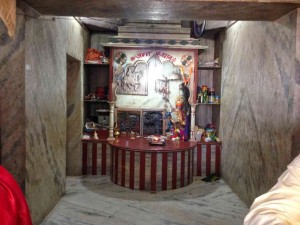 सड़क मार्ग:
सड़क मार्ग:
चंडीगढ़–गोगामेड़ी (NH 65)
-
- जयपुर, दिल्ली, लुधियाना, चंडीगढ़ और जोधपुर से निजी कार, राजस्थान राज्य सड़क परिवहन निगम या निजी बसों द्वारा या फिर टैक्सी द्वारा भी पहुंचा जा सकता है।
हवाई मार्ग:
निकटतम हवाई अड्डा:
-
- चंडीगढ़ अंतर्राष्ट्रीय हवाई अड्डा (IXC), मोहाली जिला, पंजाब
- महाराणा प्रताप हवाई अड्डा (UDR), उदयपुर, राजस्थान
रेल मार्ग:
निकटतम रेलवे स्टेशन:
-
- हनुमानगढ़ जंक्शन – HMH
- सादुलपुर जंक्शन – SDLP
- गोगामेड़ी जंक्शन – GAMI
टिप्पणी:
यदि आप हमारी पारम्परिक लोक-कथाओं को पुनर्जीवित करना चाहते हैं या गोगाजी की कथा में दिलचस्पी रखते हैं तो निम्न लिंक पर क्लिक करें और गोगाजी की लोक-कथा जो भाट-चारणों द्वारा गाई जाती थी का आनंद उठा सकते हैं।
माता भद्रकाली का मंदिर
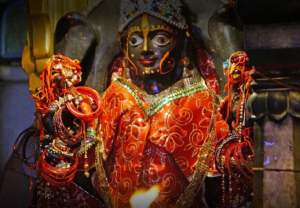 हनुमानगढ़ से 7 किलोमीटर की दूरी पर स्थित, माता भद्रकाली का यह मंदिर घाघरा नदी के तट पर है। मंदिर देवी दुर्गा के कई अवतारों में से एक को समर्पित है। बीकानेर के छठे राजा महाराजा राम सिंह द्वारा निर्मित, देवी दुर्गा की मूर्ति को पूरी तरह से लाल पत्थर से देवी दुर्गा की मूर्ति को पूरी तरह से लाल पत्थर से बनी हुईहैं। मंदिर पूरे सप्ताह भक्तों के लिए खुला रहता है।
हनुमानगढ़ से 7 किलोमीटर की दूरी पर स्थित, माता भद्रकाली का यह मंदिर घाघरा नदी के तट पर है। मंदिर देवी दुर्गा के कई अवतारों में से एक को समर्पित है। बीकानेर के छठे राजा महाराजा राम सिंह द्वारा निर्मित, देवी दुर्गा की मूर्ति को पूरी तरह से लाल पत्थर से देवी दुर्गा की मूर्ति को पूरी तरह से लाल पत्थर से बनी हुईहैं। मंदिर पूरे सप्ताह भक्तों के लिए खुला रहता है।
https://www.youtube.com/watch?v=2JlVHjswy7Q
https://www.youtube.com/watch?v=wyJaScyTrhM
सिल्ला माता का मंदिर, हनुमानगढ़
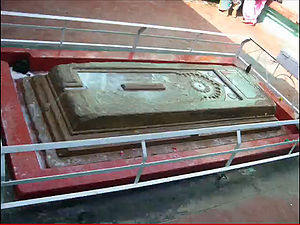 18 वीं शताब्दी में स्थापित सिला माता मंदिर, हनुमानगढ़ शहर में स्थित है। सिला या सिल्ला संस्कृत शब्द ‘शिला’ का अपभ्रंश हैं जिस का अर्थ पत्थर का एक शिलापट्ट है ऐसी मान्यता हैं कि मंदिर में स्थित यह सिल्ला घग्गर नदी से बहकर आया था।
18 वीं शताब्दी में स्थापित सिला माता मंदिर, हनुमानगढ़ शहर में स्थित है। सिला या सिल्ला संस्कृत शब्द ‘शिला’ का अपभ्रंश हैं जिस का अर्थ पत्थर का एक शिलापट्ट है ऐसी मान्यता हैं कि मंदिर में स्थित यह सिल्ला घग्गर नदी से बहकर आया था।
-
- यह मंदिर वैदिक नदी सरस्वती के प्राचीन बहाव क्षेत्र में स्थित है।
- ऐसी मान्यता है कि जो कोई भी सिल्ला माता के ‘सिल्ला पीर’ में दूध और जल चढ़ाता है, उसे त्वचा संबंधी रोगों से छुटकारा मिलता है।
- इस मंदिर में प्रत्येक गुरुवार को मेला लगता है।
ब्राह्मणी माता का मंदिर, पल्लूकोट:
इस प्रसिद्ध मंदिर का विवरण मुखपृष्ठ पर दिया गया है।
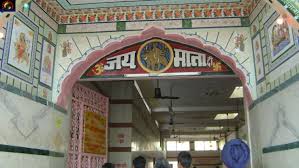
References:
https://en.wikipedia.org/wiki/Bhatner_fort
https://bharatdiscovery.org/india/सिल्ला_माता_मंदिर_हनुमानगढ़
Tourist Attraction in Hanumangargh
HISTORY
Located about 400 km from Delhi, Hanumangarh is well connected by road and rail. Hanumangarh is popular for its temples. It was once a part of the Indus Valley Civilization, thus has a historical significance. Recent excavations in the area have revealed some stunning art effects belonging to an era of great significance to human history.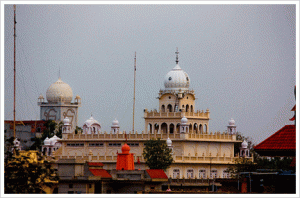
Hanumangarh is also an agricultural market place where cotton and wool are woven on handlooms and sold. Numerous festivals mark the city throughout the year, some of the well-known ones being the Bhadrakali Mela, Gogamedi Mela, Pallu Mela, Shila Mata Mela, Mahitab Singh Yadgari Mela and so on. Some of these festivals are celebrated weekly and some yearly. Pilgrims from the North of India attend these festivals in great numbers.
Hanumangarh was originally called Bhatner since it was the kingdom of the Bhati kings. When Raja Suraj Singh of Bikaner captured the town on a Tuesday (a day dedicated to Lord Hanuman) he renamed it ‘Hanumangarh’.
This region was a significant travel route on the Delhi-Multan highway for the traders who used to travel from Central Asia, Sindh and Kabul to Delhi and Agra via Bhatner.
How to reach Hanumangargh:
By Air:
Chandigarh is the nearest airport (312 kilometres) to Hanumangarh with daily flights from Mumbai, Delhi and other major metros around the country.
By Road:
Hanumangarh is well connected via road with Jaipur, Delhi, Ludhiana, Chandigarh and Jodhpur. Hiring a car is the best option but there are many bus services available, private and those run by the Rajasthan State Road Transport Corporation.
By Rail:
Hanumangarh has good rail connections to Jalore, Agra, Delhi, Jaipur and Guwahati with a number of trains halting at the Hanumangarh Railway Station throughout the week.
Tourist attractions :
There are many tourist attractions in and around Hanumangargh district.
Historical attractions :
1. Bhatner Fort
The primary tourist attraction of Hanumangarh is the oldest fort in India, the ‘Bhatner fort’, a beautiful structure whose history dates back thousands of years.
This fort situated on the bank of River Ghaggar, was built in 253 CE by Bhupat, son of king Bhati of Jaisalmer. After losing a war, King Bhupat took shelter in the jungles around the Ghaggar River. There he constructed a safe castle for himself which came to be known as Bhatner fort. The entire fort is built of bricks, covering an area of 52 acres and has the shape of a parallelogram, with a dozen bastions on each side. This fort is heavily fortified and has many stunning gates. It has temples that are dedicated to Lord Shiva and Lord Hanuman. Painted Grey Ware dating back to 1100-800 BCE and Rang-Mahal Ware (1st-3rd century CE) have been found in the wells situated along the wall.
In the middle of the thirteenth century, Sher Shah Suri, a cousin or nephew of Balban (the Sultan of Delhi), was the governor in these parts of the  country. In 1391, Bhatner was wrested by Timur by defeating Bhatti King Rao Doolchand. This is mention in “Tuzuk-e-Timuri” (Autobiography of Timur) that this fort was one of the strongest and secure forts of India. During the Timur invasion of India in 1398, Timur took 10,000 soldiers from his main army of 92,000 which was advancing towards Delhi under his grandson and captured the Bhatner fort, ransacked the city and destroyed its fortifications. Even Mughal Emperor Akbar described his fortification in his book “Ain-i-Akbari”.
country. In 1391, Bhatner was wrested by Timur by defeating Bhatti King Rao Doolchand. This is mention in “Tuzuk-e-Timuri” (Autobiography of Timur) that this fort was one of the strongest and secure forts of India. During the Timur invasion of India in 1398, Timur took 10,000 soldiers from his main army of 92,000 which was advancing towards Delhi under his grandson and captured the Bhatner fort, ransacked the city and destroyed its fortifications. Even Mughal Emperor Akbar described his fortification in his book “Ain-i-Akbari”.
Over period of time, the fort has been held by Bhatis, Johiyas and Chayals until 1527 when it was taken by Rao Jet Singh of Bikaner. After that, it came twice under Mughal control as well, in addition to being the possession of the royal families of Chayal and Bikaner.
 Researchers believe that famous Battle of Tarain fought between Mohammad Ghori and Prithviraj Chauhan is the present Talwara Jheel area of the district. This fort stands in the path of invasions of India from Central Asia and had acted as a strong barricade against the attack of enemies. Finally in the year 1805, it was captured by Emperor Suraj Singh of Bikaner and remained with him till the formation of Rajasthan.
Researchers believe that famous Battle of Tarain fought between Mohammad Ghori and Prithviraj Chauhan is the present Talwara Jheel area of the district. This fort stands in the path of invasions of India from Central Asia and had acted as a strong barricade against the attack of enemies. Finally in the year 1805, it was captured by Emperor Suraj Singh of Bikaner and remained with him till the formation of Rajasthan.
2. Kaligangan Site
Kalibangan is famous as a site where relics from the Indus Valley Civilization were unearthed. These relics belong to the Harappan and pre-Harappan settlements from the year 2500 BC. Excavations at Kalibangan have revealed Harappan seals, human skeletons, unknown scripts, stamps, copper bangles, beads, coins, toys, terracotta and shells.
 3. Archaeological Museum: This museum was set up in 1983 to house the findings from the excavation conducted on the Harappan site during 1961-1969. The museum has three galleries – one pre-Harappan one and two devoted to Harappan artefacts.
3. Archaeological Museum: This museum was set up in 1983 to house the findings from the excavation conducted on the Harappan site during 1961-1969. The museum has three galleries – one pre-Harappan one and two devoted to Harappan artefacts.
Note:
For more details please read the’ Heritage of Hanumangargh’ a subsection in the main menu under ‘Archaeology’.
Religious Attractions:
Temple of Shri Gogaji
 Around 120 km from the city of Hanumangarh lies the Temple of Shri Gogaji in a village called Gogamedi. Legend has it that Gogaji was a warrior who possessed spiritual powers. He is also referred to as the ‘God of Snakes’. The temple was built in his honour almost 900 years ago by Bikaner’s Maharaja Shri Ganga Singh and it stands on an elevated mount.
Around 120 km from the city of Hanumangarh lies the Temple of Shri Gogaji in a village called Gogamedi. Legend has it that Gogaji was a warrior who possessed spiritual powers. He is also referred to as the ‘God of Snakes’. The temple was built in his honour almost 900 years ago by Bikaner’s Maharaja Shri Ganga Singh and it stands on an elevated mount.
The architecture of the temple is mix of Muslim and Hindu styles and has two minarets above the shrine which houses the main idol. Constructed from stone and lime mortar, the flooring done in white and black marble tiles. People of all faiths visit this temple. The temple has a beautiful, engraved statue of Gogaji as a warrior riding a blue horse, with a lance in his hand and a snake around his neck.
He is a local deity and highly revered as he is capable of healing a person suffering from snakebite and other diseases. Gogaji is worshiped not only in Rajasthan but also in Madhya Pradesh, Uttar Pradesh, Punjab, Haryana and Himachal Pradesh.
Legendry Gogaji
 Maharaja Gogaji was a popular Chauhan clan king in Rajasthan. His original name was Jaharveer. His cousins Archan and Sarchon were men of evil intent and desired to kill Jaharveer after kidnapping his wife Shreeyal. Jaharveer got to know their plan and killed them. Jarahveer’s mother Bachchal could not bear this and directed the king to leave the kingdom. Thereafter Jaharveer left the palace and started living in a forest. However, he continued to meet his wife secretly.
Maharaja Gogaji was a popular Chauhan clan king in Rajasthan. His original name was Jaharveer. His cousins Archan and Sarchon were men of evil intent and desired to kill Jaharveer after kidnapping his wife Shreeyal. Jaharveer got to know their plan and killed them. Jarahveer’s mother Bachchal could not bear this and directed the king to leave the kingdom. Thereafter Jaharveer left the palace and started living in a forest. However, he continued to meet his wife secretly.
Eventually his mother got to know about these meetings. Jaharveer could not face his mother for disobeying her command of not coming to the palace ever again, therefore he got himself enshrined in the ground along with his horse at Gogamedi.
Gogamedi festival
 A grand fair is held at Gogamedi in August in memory of Gogaji. The fair is held from the ninth day (Goga Navami) to the eleventh day of the Krishna paksh of Bhaadra month. This festival is a big tourist attraction.
A grand fair is held at Gogamedi in August in memory of Gogaji. The fair is held from the ninth day (Goga Navami) to the eleventh day of the Krishna paksh of Bhaadra month. This festival is a big tourist attraction.
Devotees from all over Rajasthan participate in the fair with enthusiasm and delicacies prepared with honey, sugar and coconut are offered to him. Musicians from all over Rajasthan come here to showcase their talent.
Gogamedi is famous for its major animal fair in this region. Animal traders from all over India come here for trading, especially for camels.
Gogamedi is famous for its panoramic view, making it a place for nature photography.
How to Reach:
 By Road:
By Road:
-
- Accessible by NH 65 from Chandigarh
- By private buses or those run by the Rajasthan State Road Transport Corporation from Jaipur, Delhi, Ludhiana, Chandigarh and Jodhpur.
Nearest Airport:
-
- Chandigarh International Airport (IXC), Mohali District, Punjab
- Maharana Pratap Airport (UDR), Udaipur, Rajasthan
Nearest Railway Station:
-
- Hanumangarh Junction [Station Code – HMH]
- Sadulpur Junction [Station Code – SDLP]
- Gogamedi Junction [Station Code – GAMI]
Note:
If you want to revive our traditional folk tales or are interested in the story of Gogaji, then click on the following link and enjoy the folk tales of Gogaji which were sung by the bhat-charanas.
https://www.ohmyrajasthan.com/gogamedi-temple
Temple of Mata Bhadrakali
 Located at a distance of 7 kms from Hanumangarh, this temple of Mata Bhadrakali is on the banks of the Ghaggar River. The deity the temple is dedicated to one of the many avatars of Goddess Durga. Constructed by the sixth king of Bikaner Maharaja Ram Singh, Goddess Durga idol was made entirely out of red stone. The temple is open to the public throughout the week.
Located at a distance of 7 kms from Hanumangarh, this temple of Mata Bhadrakali is on the banks of the Ghaggar River. The deity the temple is dedicated to one of the many avatars of Goddess Durga. Constructed by the sixth king of Bikaner Maharaja Ram Singh, Goddess Durga idol was made entirely out of red stone. The temple is open to the public throughout the week.
https://www.youtube.com/watch?v=2JlVHjswy7Q
https://www.youtube.com/watch?v=wyJaScyTrhM
Temple of Sila Mata, Hanumangarh
 Sila Mata Temple, established in the 18th century, is located in the city of Hanumangarh. It is said that the ‘sila’ meaning a slab of stone which had flowed from the Ghaggar River was installed in the temple.
Sila Mata Temple, established in the 18th century, is located in the city of Hanumangarh. It is said that the ‘sila’ meaning a slab of stone which had flowed from the Ghaggar River was installed in the temple.
- This temple is located at the ancient drift area of the Vedic river Saraswati.
- There is a belief that anyone who offers milk and water in the ‘Sila Pir’ of Sila Mata gets rid of skin related diseases.
- A fair is held in this temple every Thursday.
Temple of Brahmani Mata, Pallukot
 Details of this famous temple are given on the homepage.
Details of this famous temple are given on the homepage.
References
https://en.wikipedia.org/wiki/Bhatner_fort
https://bharatdiscovery.org/india/सिल्ला_माता_मंदिर_हनुमानगढ़

